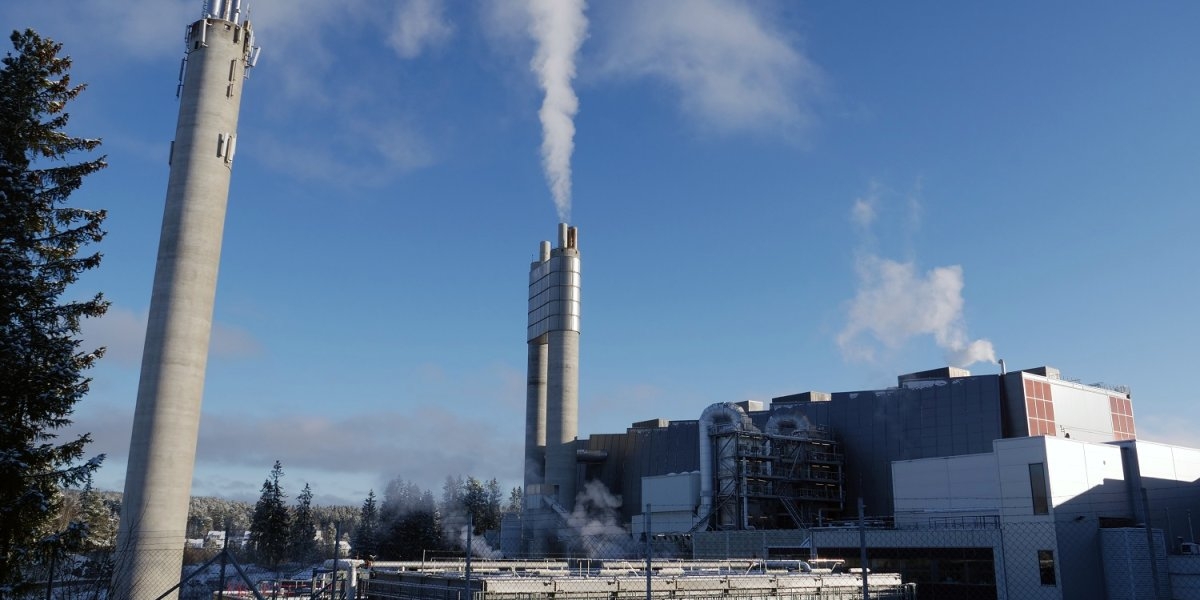THE WASTE INCINERATION PLANT AT KLEMETSRUD OUTSIDE OSLO. PHOTO: AMUND AASBRENN
What is carbon capture?
We know that global greenhouse gas emissions must be reduced. And carbon capture and storage is drawing increasing interest as an important solution to achieving that goal. Coal power plants and cement production, ocean storage of co₂ emissions, Longship for transporting co₂ along the coastline ... It can all be confusing, so here is a brief explanation.
1. What is carbon capture and storage?
Carbon dioxide (co₂) is a colourless gas and an important part of the global carbon cycle. Human activity – particularly the burning of fossil energy sources – has increased the amount of co₂ in the atmosphere and thereby accelerated the natural greenhouse effect. This is regarded to be main cause of today's global warming. The process is commonly known as carbon capture and storage (CCS).
In the carbon capture process, co₂ is captured from a point of discharge (such as a cement factory or a waste disposal plant) and separated using a liquid solvent. The gas is separated from the liquid by heating and compressing it into a liquid state, and is then transported to a site where it is pumped down through a well for permanent storage in the bedrock. The intention is to prevent co₂ emissions entering the atmosphere by storing them permanently.
Capturing co₂ from sources as small as diesel vehicles is ineffective; it is intended to manage large emissions from fossil fuels and industry. Much of today's co₂ emissions come from industry and power production based on coal and gas. If we are to get rid of these emissions, we really have only two options: either shut down the production plants or capture and store the emissions they produce.
2. Carbon capture and storage makes it easier to reach the climate targets
Capturing and storing co₂ makes it possible to reduce total emissions sufficiently to hold global warming to under 2 degrees. Few other ways of reducing emission are as effective. If the world is to reach the target in the Paris Agreement, we must drastically reduce emissions. We must replace oil, coal and gas with wind, hydro and solar energy. But we do not have time to wait for such an energy revolution, so in the meantime we must remove the co₂ emissions from fossil energy production. In addition, we must remove co₂ from industrial processes on which we will continue to be dependent for a long time to come, such as cement production.
3. Norway has moved quickly and has come a long way
Norway has come a long way in managing its co₂ emissions. Sintef researchers conceived the idea of carbon storage in the 1980s and have been researching it ever since. In 1996 Norway began pumping co₂ from a platform in the North Sea down into the bedrock for storage. It did so because the level of co₂ in the gas from the platform was too high to sell it. This had to do with the introduction of a tax that was imposed in 1991 on co₂ emissions; any greenhouse gas emitted would have a tax levied on it. Also, Statoil wanted to test whether carbon capture and storage worked, so it quickly began separating co₂ from the gas extracted from the Sleipner field in the North Sea.
4. The biggest challenge to carbon capture: cost
Yes, it is possible to capture and store co₂ in the bedrock, but it is expensive. Few carbon capture plants currently exist in the world (between 20 and 30). The reason is the high cost, so the value derived from operating them must justify it. The alternative is to discharge co₂ instead of capturing it. And even where tax is levied on emissions, it is still cheaper than capturing and storing it.
Norcem (which deals in cement production) burns limestone in its production process, and therefore emits large amounts of co₂ into the atmosphere. Cement production accounts for approximately eight per cent of global anthropogenic emissions.
5. Could Longship be the solution?
Longship is the largest ever climate project in Norwegian industry, and represents a massive investment in co₂ management. It involves the capture of co₂ from industrial sources for subsequent transport and safe storage. The gas will first be captured at a waste incineration plant and a cement factory and condensed into liquid form before being transported, first by ship to Western Norway and then by pipeline into the North Sea, where it will be safely stored two to three kilometres beneath the seabed.
No other country has such a system, but Norway has suitable conditions for storage in the North Sea. This will make it attractive to other countries and, gradually, to other co₂ emission sources in Norway, to connect to.
The future success of the Longship project is dependent on other countries adopting this technology and learning from it. Several countries and companies have shown great interest in the Longship project and in Norway's achievements in full-scale management of co₂. The business side of establishing the infrastructure for transporting captured co₂ from emission sites for storage in Western Norway is called Northern Lights.
